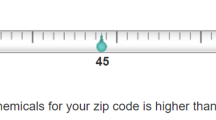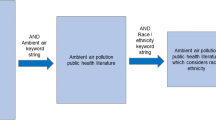Abstract
It is well known that environmental burdens are more pronounced in socioeconomically disadvantaged communities, a phenomenon known as environmental injustice. Yet, there have been few studies that have addressed whether the degree of environmental injustice has changed over time. We analyze toxic releases in the United States over the first 26 years of the toxics release inventory and examine whether the decreases in toxic releases differ according to characteristics of the communities in which the emitters reside. We find that decreases over these years are universal but far more substantial in high-income areas. Our results speak to both the nascent literature on information disclosure and that on environmental justice.
Similar content being viewed by others
Notes
For details of this order, see http://www2.epa.gov/laws-regulations/summary-executive-order-12898-federal-actions-address-environmental-justice.
While the data are widely available, the data are complex enough that groups such as the Right-to-Know network and academic researchers are still active in aggregating the data and analyzing trends.
References
Agarwal, N., Banternghansai, C., & Bui, L. T. M. (2010). Toxic exposure in America: Estimating fetal and infant health outcomes from 14 years of TRI reporting. Journal of Health Economics, 29, 557–574.
Austin, R., & Schill, M. (1991). Black, brown, poor, and poisoned: Minority grassroots environmentalism and the quest for eco-justice. Kansas Journal of Law and Public Policy, 1, 69.
Berchicci, L., & King, A. (2007). Postcards from the edge: A review of the business and environment literature. The Academy of Management Annals, 1, 513–547.
Bollinger, B., Leslie, P., Sorensen, A. (2010). Calorie posting in chain restaurants (No. w15648). National Bureau of Economic Research, Cambridge.
Campbell, H. E., Peck, L. R., & Tschudi, M. K. (2010). Justice for all? A cross-time analysis of toxics release inventory facility location. Review of Policy Research, 27(1), 1–25.
Chakraborty, J., Maantay, J. A., & Brender, J. D. (2011). Disproportionate proximity to environmental health hazards: Methods, models, and measurement. Journal Information, 101(S1), S27–S36.
Chatterji, A. K., Levine, D. I., & Toffel, M. W. (2009). How well do social ratings actually measure corporate social responsibility? Journal of Economics & Management Strategy, 18(1), 125–169.
Chatterji, A. K., & Toffel, M. W. (2010). How firms respond to being rated. Strategic Management Journal, 31(9), 917–945.
Delmas, M. A., & Toffel, M. W. (2012). Institutional pressures and organizational characteristics: Implications for environmental strategy. In P. Bansal & A. J. Hoffman (Eds.), The Oxford handbook of business and the environment (pp. 229–247). New York: Oxford University Press.
Doshi, A. R., Dowell, G. W. S., & Toffel, M. W. (2013). How firms respond to mandatory information disclosure. Strategic Management Journal, 34, 1209–1231.
Dowell, G., Hart, S., & Yeung, B. (2000). Do corporate global environmental standards create or destroy market value? Management Science, 46(8), 1059–1074.
Downey, L. (1998). Environmental injustice: Is race or income a better predictor? Social Science Quarterly, 79, 766–778.
Downey, L., & Hawkins, B. (2008). Race, income, and environmental inequality in the United States. Sociological Perspectives, 51(4), 759–781.
Eesley, C., & Lenox, M. J. (2006). Firm responses to secondary stakeholder action. Strategic Management Journal, 27(8), 765–781.
Environmental Protection Agency. (1997). Chemicals in the environment: History of the toxics release inventory. Accessed from http://www.epa.gov/opptintr/cie/archive/issue06j.pdf.
Etzion, D. (2007). Research on organizations and the natural environment, 1992-present: A review. Journal of Management, 33(4), 637–664.
Fortunato, L., Abellan, J., Beale, L., LeFevre, S., & Richardson, S. (2011). Spatio-temporal patterns of bladder cancer incidence in Utah (1973–2004) and their association with the presence of toxic release inventory sites. International Journal of Health Geographics, 10(16), 1–10.
Freudenberg, N., Pastor, M., & Israel, B. (2011). Strengthening community capacity to participate in making decisions to reduce disproportionate environmental exposures. Journal Information, 101(S1), S123–S130.
Fung, A., & O’Rourke, D. (2000). Reinventing environmental regulation from the grassroots up: Explaining and expanding the success of the toxics release inventory. Environmental Management, 25, 115–127.
Garcia, C., & Levenson, H. (1975). Differences between Blacks’ and Whites’ expectations of control by chance and powerful others. Psychological Reports, 37(2), 563–566.
Grant, D. S., Bergesen, A. J., & Jones, A. W. (2002). Organizational size and pollution: The case of the US chemical industry. American Sociological Review, 67, 389–407.
Grosman, G. M., & Krueger, A. B. (1995). Economic growth and the environment. Quarterly Journal of Economics, 110(2), 353–377.
Hamilton, J. T. (1995). Testing for environmental racism: Prejudice, profits, political power? Journal of Policy Analysis and Management, 14(1), 107–132.
Hart, S. L. (2010). Capitalism at the crossroads: Next generation business strategies for a post-crisis world (3rd ed.). Upper Saddle River, NJ: Pearson Education.
Hendryx, M., & Luo, J. (2013). Cancer hospitalizations in rural–urban areas in relation to carcinogenic discharges from toxics release inventory facilities. International Journal of Environmental Health Research, 23(2), 155–169.
Hester, R. T, Jr. (1987). Participatory design and environmental justice: Pas de deux or time to change partners? Journal of Architectural and Planning Research, 4, 289–300.
King, A., & Lenox, M. (2002). Exploring the locus of profitable pollution reduction. Management Science, 48(2), 289–299.
Luo, J., & Hendryx, M. (2011). Environmental carcinogen releases and lung cancer mortality in rural-urban areas of the United States. The Journal of Rural Health, 27(4), 342–349.
Luo, J., Hendryx, M., & Ducatman, A. (2011). Association between six environmental chemicals and lung cancer incidence in the United States. J Environ Public Health,. doi:10.1155/2011/463701.
Olson, M. (1965). The logic of collective action. Cambridge, MA: Harvard University Press.
Ostrom, E. (1998). A behavioral approach to the rational choice theory of collective action. American Political Science Review, 92(1), 1–22.
Ringquist, E. J. (1993). Environmental protection at the state level: Politics and progress in controlling pollution. New York: ME Sharpe.
Ringquist, E. J. (2005). Assessing evidence of environmental inequities: A meta-analysis. Journal of Policy Analysis and Management, 24(2), 223–247.
Saha, S., & Mohr, R. D. (2013). Media attention and the toxics release inventory. Ecological Economics, 93, 284–291.
Shapiro, M. (2005). Equity and Information: Information regulation, environmental justice, and risks from toxic chemicals. Journal of Policy Analysis and Management, 24(2), 373–398.
Suro, R. (1990). Grass roots groups show power battling pollution closer to home. New York Times, 2, 1.
Taylor, D. E. (2014). Toxic communities: Environmental racism, industrial pollution, and residential mobility. New York: NYU Press.
Tiebout, C. M. (1956). A pure theory of local expenditures. The Journal of Political Economy, 64, 416–424.
United Church of Christ. (1987). Toxic wastes and race in the United States: A national report on the racial and socio-economic characteristics of communities with hazardous waste cites.
Weil, D., Fung, A., Graham, M., & Fagotto, E. (2006). The effectiveness of regulatory disclosure policies. Journal of Policy Analysis and Management, 25(1), 155–181.
Weinberg, A. S. (1998). The environmental justice debate: A commentary on methodological issues and practical concerns. Sociological Forum, 13(1), 25–32.
Yandle, B., Bhattarai, M., & Vijayaraghavan, M. (2004). Environmental Kuznets curves: A review of findings, methods, and policy implications. Research study, 2, 1–16.
Author information
Authors and Affiliations
Corresponding author
Rights and permissions
About this article
Cite this article
Kalnins, A., Dowell, G. Community Characteristics and Changes in Toxic Chemical Releases: Does Information Disclosure Affect Environmental Injustice?. J Bus Ethics 145, 277–292 (2017). https://doi.org/10.1007/s10551-015-2836-5
Received:
Accepted:
Published:
Issue Date:
DOI: https://doi.org/10.1007/s10551-015-2836-5




